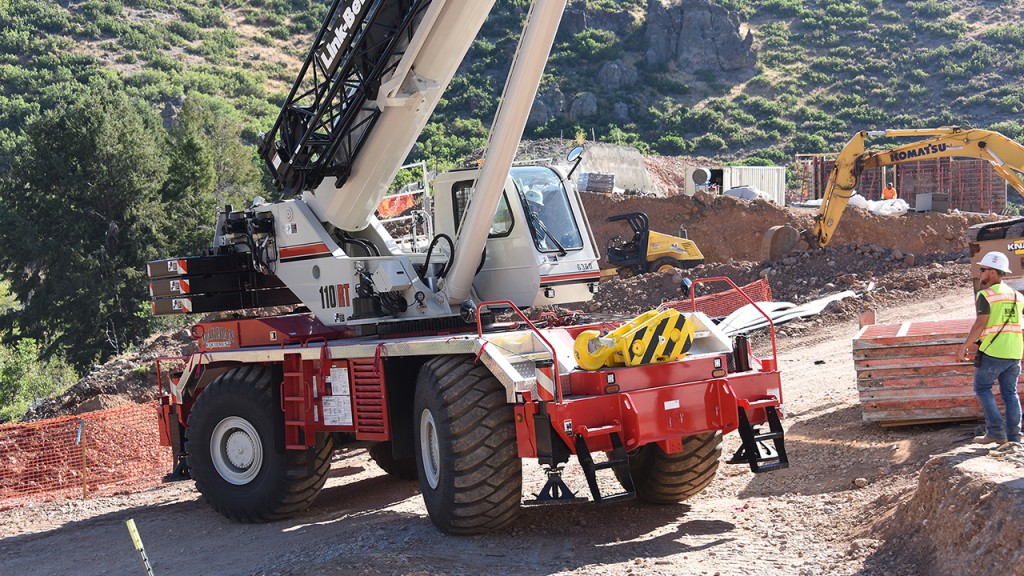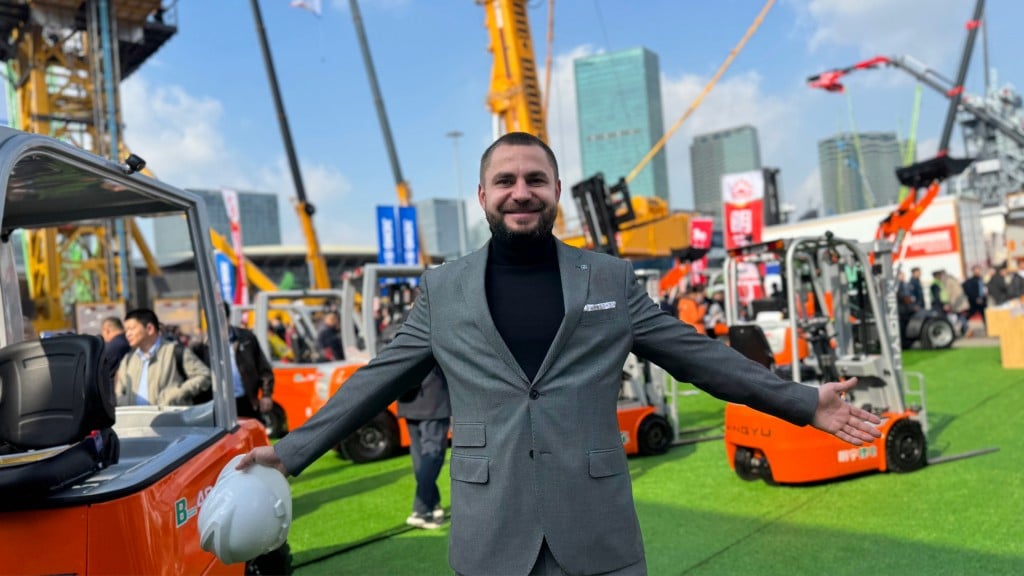
Rough-terrain cranes are the workhorse lifters on many jobsites as they provide a combination of reach, capacity and movability which makes them a popular choice for purchase or rental.
Canadian buyers lean toward larger-capacity rough-terrain cranes in the 100-ton and higher range, according to Michelle Respicio, product marketing specialist with Terex Cranes. "There is increased demand for larger capacity classes as high reach and heavier lifts become more common. The majority of these cranes are used in rental applications, such as light commercial, infrastructure and energy."
Paul Cutchall, product manager for RT cranes with Manitowoc, added that "Rough-terrain cranes work well due to their small footprint and strong lifting capacity. They are used for many purposes in general construction."
"Typically, an RT crane is the first [machine] in and last out of a project," commented Kyle Jardine, divisional director for Liebherr Canada.
Users of rough-terrain machines tend to be a combination of contractors buying their own gear and rental houses, Jardine noted. Generally, shorter-term projects in the two to three month range are served by rented cranes, while those companies handling longer jobs – one to two years or longer – tend to lean toward purchase.
"Demand for rough-terrain cranes in Canada in general is considered low, but there is great potential demand in the market, so we are paying attention to market trends," added Christian Bartley, vice president, marketing and strategic operations with Tadano. "The main application for this class of cranes is energy-related facilities – these cranes work well due to their small footprint and strong lifting capacity."
Simplicity and safety important points
Because of the split between rental and ownership when it comes to RT cranes, the design of these machines leans toward simplicity and safety. Rental companies are interested in ensuring their machines are taken care of by their users, and contractors want to be sure their operators – and their jobsites – are safe when cranes are working.
"They don't know who's going to be operating it from day-to-day, so you've got to have a machine that's got a lot of safety built in, creature comfort features for the operator, and ease of use. For instance, for years we've had cameras as standard equipment across the board so the operator can look at the winches, their blind spot, and backup cameras," related Brian Smoot, Link-Belt product manager for RT cranes.
Safety and ease of use were important parts of the design of two new models Liebherr launched at ConExpo 2017, Jardine said: the 100-ton LRT 1090-2.1 with a 154-foot full-power boom and the LRT 1100-2.1, a 110-ton machine with 164-foot pinning boom – a system in which the telescoping sections are pinned in the extended or retracted position.
"Functions such as selecting the telescoping mode (long or strong), levelling the crane, and locking the house can all be done with the push of a single button," he said. "The flat-deck, standard rear-view cameras, optional side-view cameras, and clear self-explanatory controls make the crane safe to access and work with."
According to Cutchall, some improvements in rough-terrain cranes over the last five years include pinned booms, which offer greater capacities than telescoping booms; improved modes of telescoping; the switch to electronic controllers instead of hydraulic controllers; and thinner formed-boom shapes, which have higher KSI (kilopounds per square inch) ratings to lower boom weight while maintaining required strength.
"A major innovation at Manitowoc has been the adoption of the Crane Control System (CCS) across various Manitowoc product lines. Since controls are consistent across different product lines, an operator can be as productive as possible, whether running a rough-terrain crane or a crawler," Cutchall noted. Other advances have included the development of outrigger monitoring via smart extension cylinder technology, which replaces the inherently unreliable string-potentiometer measuring design. The use of a single telescope cylinder and extension cables, as opposed to multiple telescope cylinders, to lower boom weight and enhance the load chart throughout the entire working range has also been a recent improvement, he added.
Tadano has also brought pinned booms to its rough-terrain machines, the GR-1200XL and GR-1600XL, allowing the cranes to achieve longer boom lengths and better load charts, Bartley said. Outrigger placement has also been on the company's radar since the 1990s, he noted.
"In 1991, Tadano introduced an outrigger width-detection system that allows for safe crane operations with outriggers set up in asymmetrical configurations," Bartley said.
"This has now evolved into our ‘Smart Chart' which further extends the safe working area over the outriggers when the crane is set up asymmetrically. All Tadano rough-terrain cranes have asymmetrical outrigger systems. The GR-1200XL and GR-1000XL provide the Smart Chart system, as well."
He added that the "Tadano GR series rough-terrain cranes offer many features, such as long boom lengths, strong lift charts, good transportability, the best reliability and lowest operating costs in the industry."
Link-Belt's machines are also answering a need for asymmetrical outriggers, which are popular for today's tight jobsites.
"Jobsites are getting more and more compact, and a lot of equipment and material is around so the footprint is sometimes not very useful. We've been able to come up with our version of asymmetrical outriggers called V-CALC, Variable Confined Area Lifting Capacities, which allows the operator to maximize the lift chart with the area available," Smoot said.
Liebherr's Jardine explained that the outrigger control system is aimed at ensuring user safety around its new cranes.
The VarioBase system is standard on the LRT cranes, allowing each individual outrigger beam to be extended to different lengths as dictated by site conditions, Jardine noted. The LICCON controller can then calculate the maximum load capacities precisely, throughout any slewing position, based on different outrigger positions.
As with many other industry sectors, telematics systems are growing in popularity. Bartley said that Tadano has pioneered self-diagnosing systems that simplify troubleshooting, often eliminating the need for an on-site technician.
"All current Tadano rough-terrain cranes use the Hello-Net system of telematics as an asset management tool, which is continuously improving and evolving."
With the Pulse 2.0 or RCL system on Link-Belt machines, Smoot noted, software can be remotely updated through a WiFi hotspot on a mobile phone. The RCL system has a WiFi hub in it and the operator can automatically download any software updates that his computer may need. This prevents a distributor or technician from needing to visit just to flash the software.
Terex is working to upgrade its control system on popular crane models, introducing a rough-terrain specific version of the Demag IC-1 control system.
"The IC-1 control system for Terex RT cranes was designed with the specific needs of operators in mind," Respicio said. "Crane movements can be customized and stored to meet specialized working conditions from high precision for difficult assembly work to high-speed operation, including concrete work. The system is intuitive and suits the needs of RT cranes. It gives precise control on every lift for smooth swinging performance."
In addition, Respicio noted that "Advance diagnostics offered by the IC-1 control system provide the ability to diagnose an issue by function, allowing the user to quickly pinpoint and fix the problem for maximum uptime. The monitor displays full text error codes for quick troubleshooting without the need to refer to decode the problem."
Crane selection
Tadano's Bartley said that selecting the type and size of rough-terrain crane for any particular job can be a challenge and requires a combination of intensive study and development of lift plans. "The crane can be selected based on specification and lift chart needs."
Cutchall said buyers must know what application the crane will be used for – for example, whether it will be handling heavy lifts at short radii or lifting with the boom further extended.
"What capacity will they need to lift most often and at what load radius? Can it be done with the main boom or do they need to use a swing away extension? The speed of the crane's functions must also be accounted for. Full-power telescoping booms are faster than pinned booms, but pinned booms normally offer better capacities." He added that customers need to determine "What's more important to the job: speed or capacity?"
Planning software, such as Terex Lift Plan or Liebherr's LICCON system, can be useful tools for selecting the right crane and configuration for the job.
Performance, safety and transportability
Performance, safety and transportability are key, Jardine said; he also advised that ease of operation is important, including setup, assembly and disassembly of jibs and components. Buyers should keep in mind the safety systems included, maintenance considerations, fuel efficiency, transportability, reliability and resale value.
"Transportability and overall working dimensions of the cranes are two key factors for these larger cranes," advised Respicio.
For example, she noted that "the RT 100US is cost effective to move and operate [as] it has a narrow width of just 3 m (9.8 feet) and removable counterweight, which allows it to be trailered without weight and width restrictions in most situations."
Cutchall emphasized capacity in different configurations, as well as transportability. "Rough-terrain cranes need to be hauled from site to site, so customers need to account for a trailer, the cost of permits, and the dimensions and weight of the machine being considered." In addition, he said that RT customers need to keep an open mind about the latest technologies emerging in the crane sector.
Smoot recommended that buyers keep in mind the versatility of a crane for multiple jobsites. "Find a machine that you can sit in one location, that has the boom length and capacity to reach the back of the jobsite without having to move the machine around multiple times throughout the day to make multiple lifts."
Safety is also important to keep in mind, he added.
"We hear more and more, every day, from people concerned about safety on the jobsites . . . The easier the machine is to operate, to get up and down on – things like that can save a contractor a lot of money."
Company info
1015 Sutton Drive
Burlington, ON
CA, L7L 5Z8
Website:
liebherr.com/en/can/about-liebherr/liebherr-worldwide/canada/liebherr-in-canada.html







